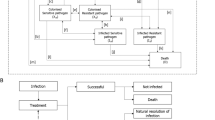Abstract
Objective: The first aim was to identify and determine the economic costs of the regimens currently used in 3 New Zealand hospitals in the treatment of bacterial infections in haematology patients with febrile neutropenia and in intensive care patients with severe infections. The second was to develop a spreadsheet-based decision analytic model for use by hospital decision-makers as an aid in evaluating the comparative cost of drug regimens.
Design and setting: The research utilised time and motion and microcosting techniques. The analytical perspective adopted for the study was that of a hospital administrator or clinical manager.
Patients and interventions: Patients were eligible for inclusion in the study if either they were treated with the imipenem/cilastatin monotherapy, or could have been treated with this regimen. The final analysis considered 360 patient-treatment days and 8 antibacterials.
Main outcome measures and results: Drug acquisition cost ranged from 4.52 New Zealand dollars ($NZ; 1997 values) per patient-treatment day for gentamicin to $NZ104.81 for imipenem. The cost per patient-treatment day (when other cost components such as fluid additives, giving sets and needles were added) ranged from $NZ8.75 for gentamicin to $NZ129.12 for tazobactam. Drug acquisition cost, as a percentage of total drug preparation and administration cost, ranged from 52% for gentamicin to 93% for piperacillin.
Giving sets and intravenous (IV) fluids were found to be important cost items when they were required specifically for the treatment regimen. There was a mean monitoring rate of 0.40 at a cost of $NZ6.41 per patient-treatment day for gentamicin. It was estimated that nephrotoxicity could add between $NZ23 and $NZ43 per day to the cost of aminoglycoside treatment
Conclusions: Although the small sample sizes of the study mean that results should be regarded as indicative rather than conclusive, there were sufficient information to construct a working model and show how the total cost of an antibacterial regimen could be evaluated in practical terms. The important cost drivers were found to be drug cost, the use of fluids and giving sets, and monitoring.
Similar content being viewed by others
References
Atkinson HC, Chambers ST, McGinlay AM. Antibiotic therapy costs. N Z Med J 1989; 102: 409–11
Drummond MF, O’Brien BJ, Stoddart GL, et al. Methods for the economic evaluation of health care programmes. 2nd ed. New York and Toronto: Oxford University Press, 1997
Luce BR, Manning WG, Siegel JE, et al. Estimating costs in cost-effectiveness analysis. In: Gold MR, Siegel JE, Russell LB, et al., editors. Cost-effectiveness analysis in health and medicine. 1st ed. Oxford: Oxford University press, 1996: 176–213
Kerr JR, Barr JG, Smyth ETM, et al. Technique for calculation of the true costs of antibiotic therapy. Eur J Clin Microbiol Infect Dis 1992; 11 (9): 823–7
Davis R, Bryson HM. Ceftriaxone: a pharmacoeconomic evaluation of its use in the treatment of serious infections. Pharmacoeconomics 1994; 6 (3): 249–69
Norton A. Nursing pay rates continue to widen. Nurs N Z 1997; 3 (8): 12
Statistics New Zealand. Personal computer information network for official statistics: a computerised database of official statistics for New Zealand and programme for manipulation and analysis of statistical series (PC INFOS). Wellington: Statistics New Zealand, 1996
Malek M, Lynch W, Wells N, et al. Antimicrobial practice: a comparison of the costs of ceftazidime therapy and gentamicin combinations in three UK hospitals. J Antimicrob Chemother 1992; 29: 207–17
Norrby SR. Pharmacoeconomic studies on antibiotics; current controversies. Pharmacoeconomics 1994; 5 (4): 274–7
Beringer PM, Wong-Beringer A, Rho JP. Economic aspects of antibacterial adverse effects. Pharmacoeconomics 1998; 13 (1): 35–49
Birmingham MC, Hassett JM, Schentag JJ, et al. Assessing antibacterial pharmacoeconoimcs in the intensive care unit. Pharmacoeconomics 1997; 12 (6): 637–47
Norrby SR, Eriksson M, Ottosson E. Imipenem-cilastatin versus gentamicin-clindamycin: a cost effectiveness study. Scand J Infect Dis 1986; 18: 371–4
Eisenberg JM, Koffer H, Glick HA, et al. What is the cost of nephrotoxicity associated with aminoglycosides? Ann Intern Med 1987; 107: 900–9
Ministry of Health. Purchasing for your health 1996/97: a performance report on the fourth year of the Regional Health Authorities (appendix eleven: RHA price database 1996/97. average base contract prices paid for AN-DRGs, version 3.1, by the RHAs in 1996/97). Wellington: Ministryof Health, 1998
Author information
Authors and Affiliations
Corresponding author
Rights and permissions
About this article
Cite this article
Scott, G., Scott, H.M., Henderson, S. et al. Cost Comparison of Antibacterial Therapies for Serious Infections. Pharmacoeconomics 16, 183–192 (1999). https://doi.org/10.2165/00019053-199916020-00007
Published:
Issue Date:
DOI: https://doi.org/10.2165/00019053-199916020-00007




